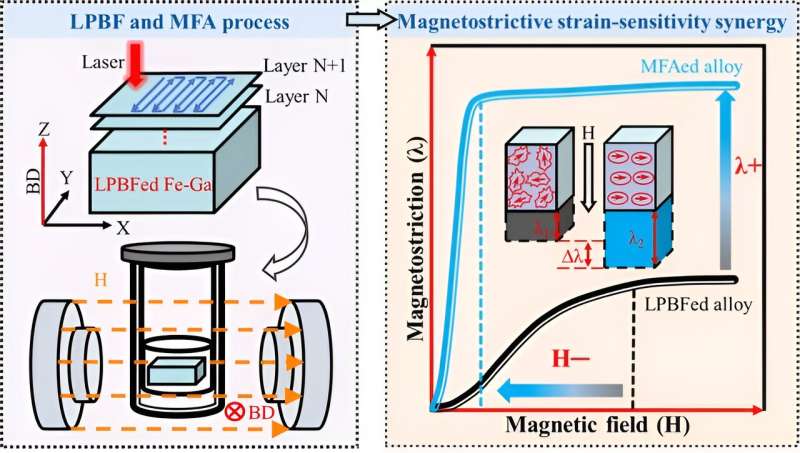This article has been reviewed according to Science X's editorial process and policies. Editors have highlighted the following attributes while ensuring the content's credibility:
fact-checked
proofread
Enabling magnetostrictive strain-sensitivity synergy in polycrystalline Fe₈₁Ga₁₉ alloys

Magnetostrictive Fe-Ga alloys with low temperature dependence, high permeability, and good mechanical properties have gained increasing attraction among various magnetostrictive materials. In particular, polycrystalline Fe-Ga alloys exhibit wide potential in applications such as sensors, actuators and implants owing to their structural variety and low production costs.
Nevertheless, polycrystalline Fe-Ga alloys are limited by a tradeoff between large magnetostrictive strain and high sensitivity due to their inverse relationships with magnetic anisotropy. This prompts swift actions to overcome the bottleneck between magnetostrictive strain and sensitivity for wider range of applications.
The magnetostrictive strain of Fe-Ga alloys is closely associated with the grain and domain structures, while the essence of magnetostrictive sensitivity lies in the ease for the motion of magnetic domains during the magnetization process. This process is subjected to various factors, including domain structure, dislocation density and grain boundary.
In a study published in the journal Advanced Powder Materials, a group of researchers from China and France proposed a novel strategy to realize the synergetic enhancement of magnetostrictive strain and sensitivity in polycrystalline Fe-Ga alloys.
"A combined process route of laser-beam powder bed fusion (LPBF) and magnetic field annealing (MFA) was proposed for the first time: polycrystalline Fe-Ga alloys with preferentially oriented grains were prepared by using LPBF process featuring high temperature gradient," explains one of the study's corresponding authors, Chengde Gao, a professor at Central South University. "Subsequently, MFA treatment was used to manipulate the domain structure and the motion resistance of magnetic domains."
The multidisciplinary team found that columnar <001> oriented grains and 90° domains developed by LPBF and MFA contributed to the increased effective magnetic anisotropy constant, leading to an improvement in magnetostrictive strain. Moreover, the resistance of magnetic domain motion was effectively diminished due to the smooth domain structures and low dislocation densities, demonstrating a fruitful magnetostrictive strain-sensitivity synergy.
"This combined process route of LPBF and MFA not only broke through the bottleneck between magnetostrictive strain and sensitivity for Fe-Ga alloys, but also enabled the preparation of diverse geometries and structures," adds Cijun Shuai, the study's senior and co-corresponding author, also a professor at Central South University.
"In other words, this study may offer fresh insights for the integrated manufacturing of magnetostrictive alloys with high performance and personalized structure, enabling a wider range of potential applications."
More information: Xiong Yao et al, Magnetostrictive strain-sensitivity synergy for laser-beam powder bed fusion processed Fe81Ga19 alloys by magnetic field annealing, Advanced Powder Materials (2024). DOI: 10.1016/j.apmate.2024.100216
Provided by KeAi Communications Co.





















